This tutorial on how to make Swiss Meringue buttercream is the only resource you’ll need to make the smoothest, silkiest frosting!
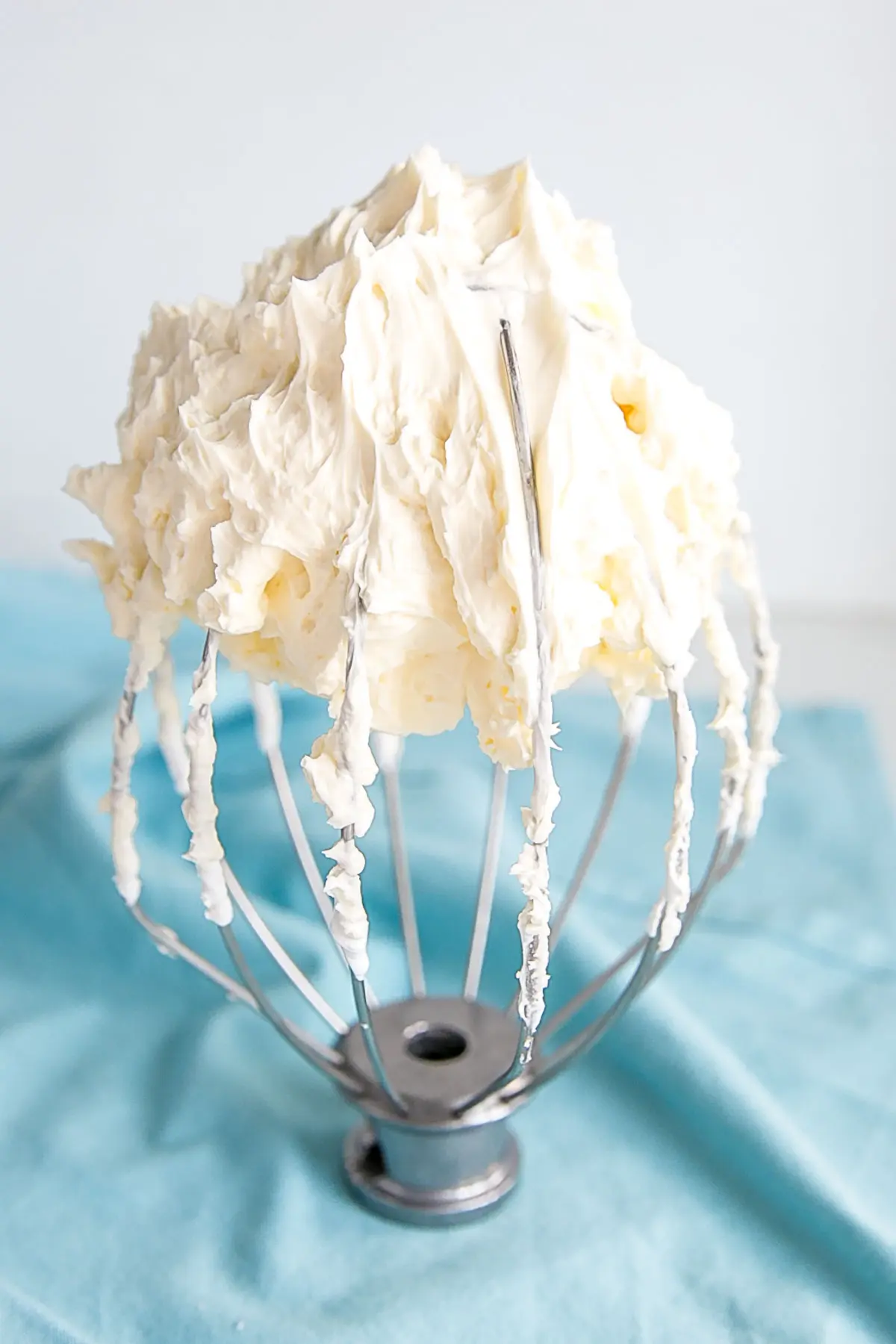
The topic of Swiss meringue buttercream comes up regularly in my Baking group on Facebook and in comments on some of my recipes here — how to make it, but more often how to deal with it when it’s just not cooperating.
Meringue buttercreams can be a bit temperamental, but whatever state you’ve got it in (provided you started with a stiff peak meringue) is totally saveable.
If you love Swiss meringue buttercream as much as I do, hopefully, you’ll find these tips useful.
If you’ve never tried it and are intimidated by it, I hope this tutorial will give you the confidence to give it a shot.
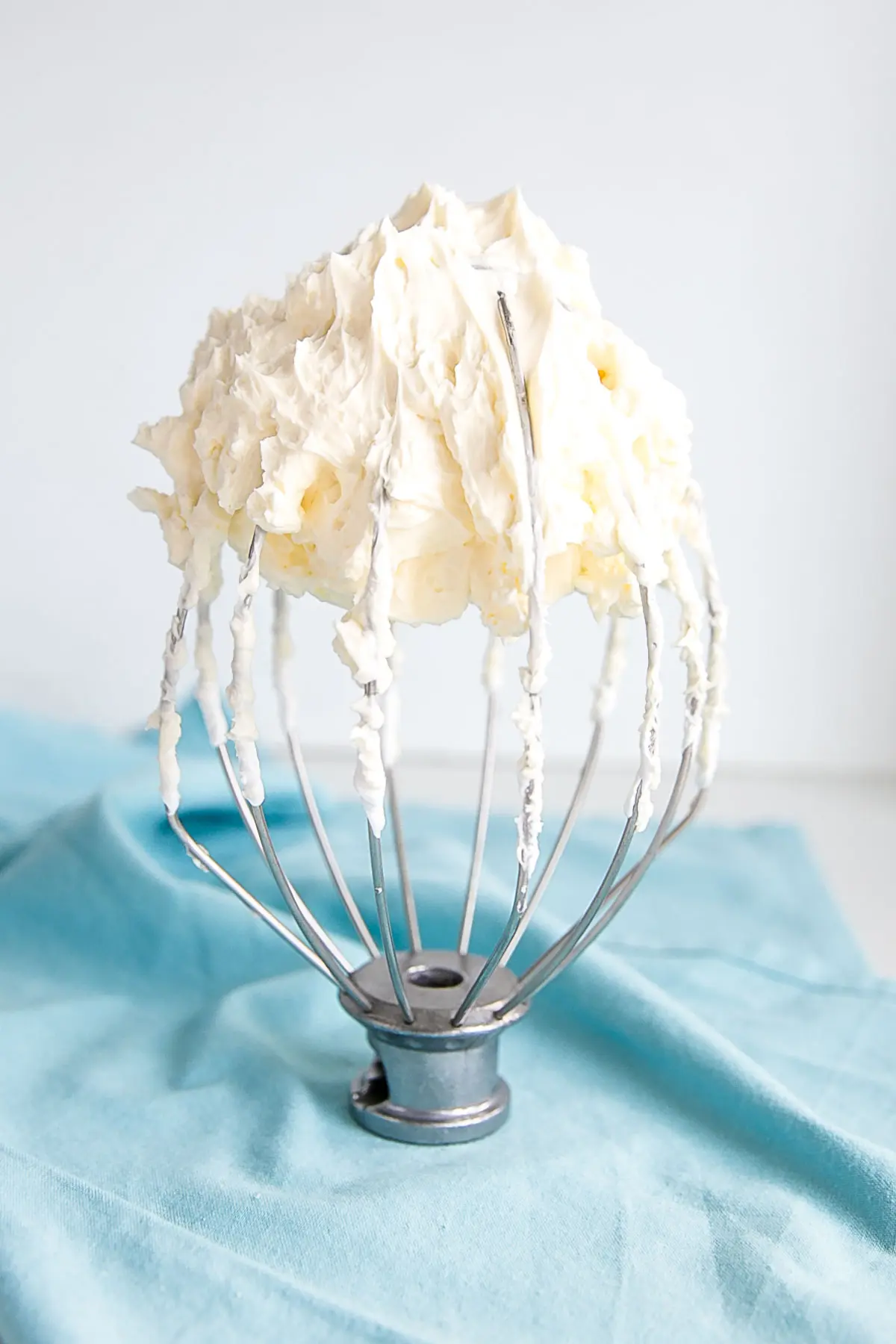
What is Swiss Meringue Buttercream?
Though more involved than an American buttercream, Swiss meringue buttercream (SMBC) is the easiest of the meringue buttercreams. It involves cooking eggs and sugar over a double boiler, whipping them into a meringue, then adding butter and flavorings.
The other two meringue buttercreams (Italian and French) both involve pouring boiling sugar into a partially whipped egg and sugar mixture.
They are equally delicious and known to be a bit more stable, but I find boiling sugar to be stressful and intimidating, so generally stay away from it as much as possible.
If you’re feeling adventurous though and you’ve tried SMBC before, I encourage you to give those a go and see how you like them.
Swiss meringue buttercream consists of 3 very simple ingredients:
- Egg whites
- Sugar
- Unsalted butter
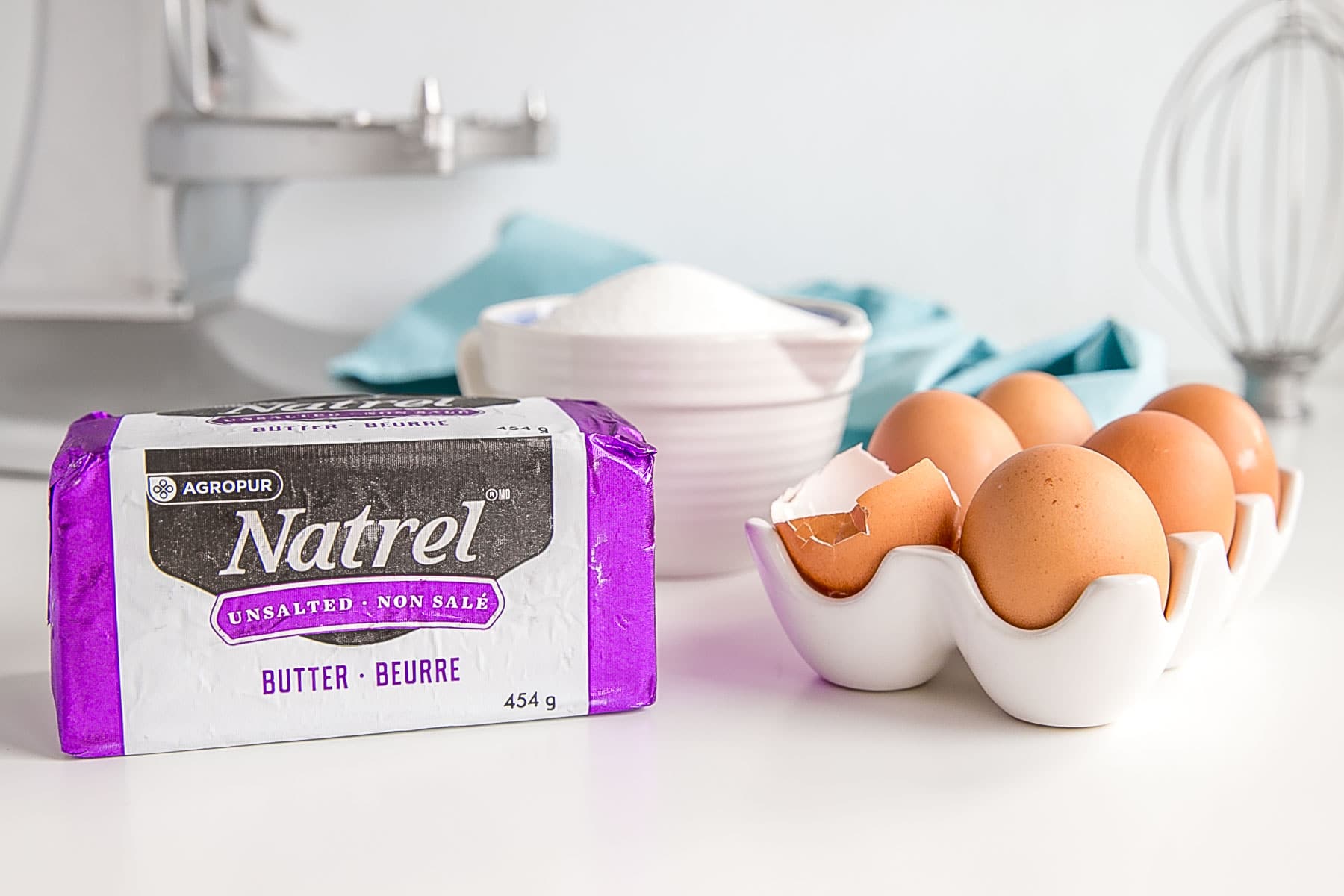
From there, you can flavor to your heart’s content. A simple and standard recipe will include vanilla, but the flavor possibilities are limited only by your imagination.
You can add melted chocolate for a milk, white, or dark chocolate Swiss meringue buttercream, freeze-dried berries for fruit flavor and color, peanut butter/peanut butter powder (preferred), or choose from a variety of flavorings to add in.
How to Make Swiss Meringue Buttercream
I’m going to take you through each step of the process here and call out tips or issues you may run into.
I recommend using a stand mixer for this buttercream. You likely could do it with a hand mixer, but it would be a more painful process — you’d be holding that hand mixer for a good 20+mins. As such, the steps I describe are for a stand mixer, but you can adapt to a hand mixer if that’s all you have to work with.
The very first thing you must do, this is NOT optional, is:
Step #1 – Wipe down all tools with lemon juice or vinegar
To help ensure a stable and stiff meringue, you must make sure that everything that will come in contact with the egg whites is completely grease-free. This includes things like your:
- mixer bowl
- whisk attachment
- hand whisk
- measuring cup (that will be used to scoop sugar)
- small bowl(s) (to crack eggs into when separating whites)
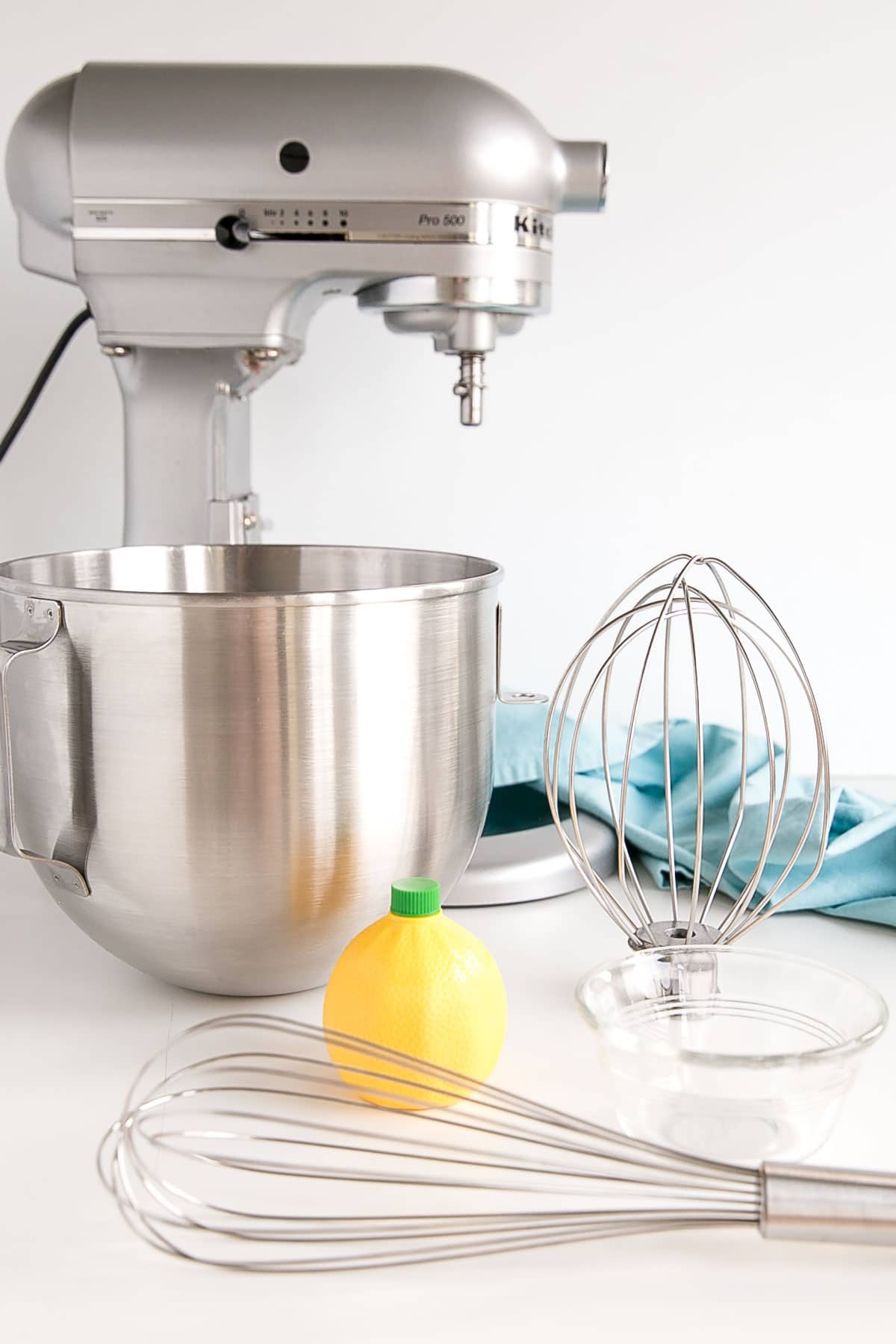
Grease is meringue’s enemy.
Even the tiniest speck of grease (or egg yolk) will cause the meringue to not whip to a stiff peak and result in a less-than-perfect (aka dense and greasy) Swiss meringue buttercream.
Another important tip here is to not use plastic tools, especially bowls, when making Swiss meringue. Plastic has a tendency to retain grease no matter how thoroughly it’s cleaned.
Best to be safe and stick to metal (preferred) or glass bowls.
Step #2 – Bring a medium pot of water to a simmer (1-2 inches of water)
You’ll want a pot that’s big enough to comfortably place your mixer bowl onto, but not so big that the bottom of the bowl touches the water.
You want a maximum of 1-2 inches of water in the pot. Bring this to a boil, then reduce to a low simmer.
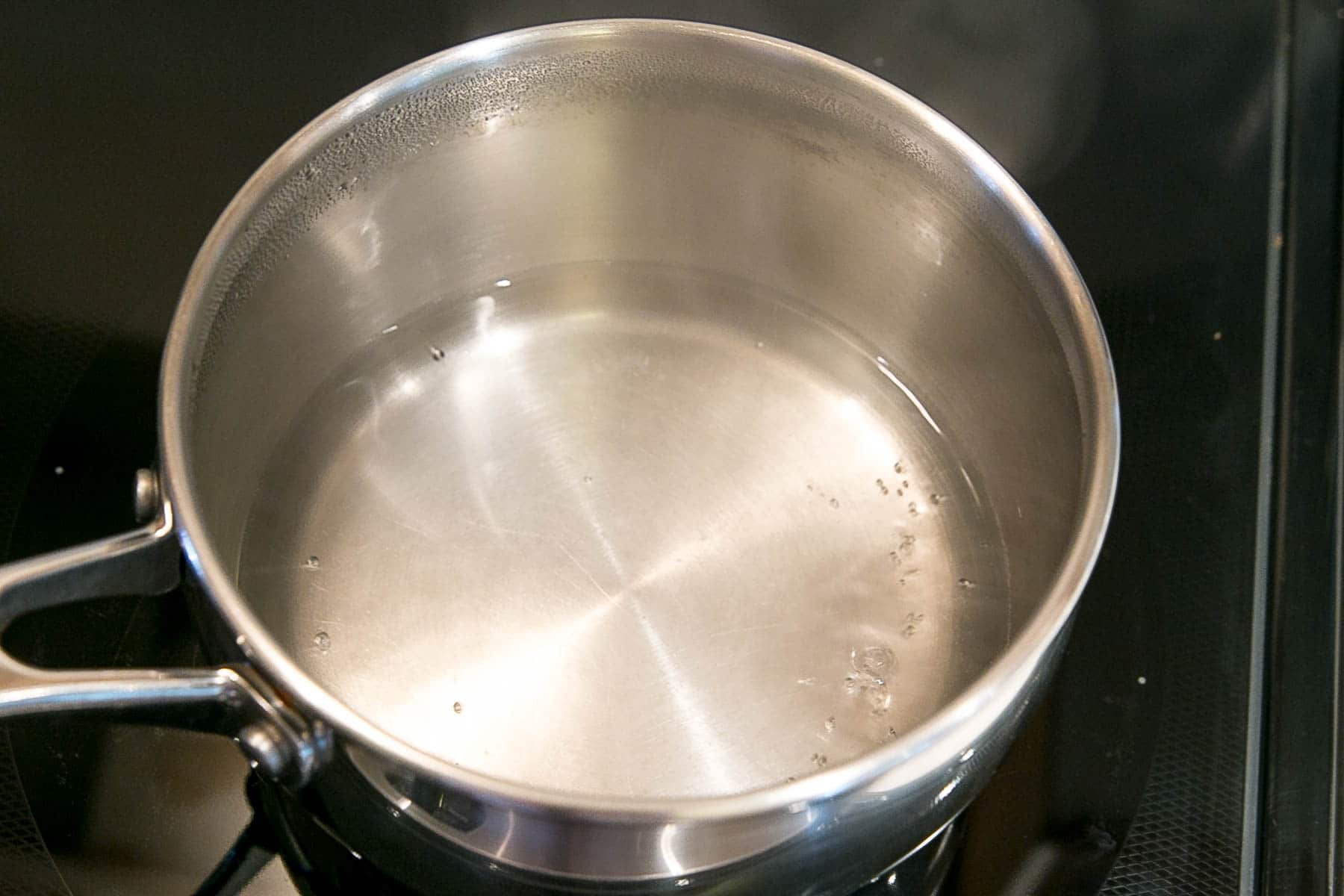
Step #3 – Separate your egg whites
Separate each egg white into a small bowl, then transfer into your mixer bowl.
Do not separate the egg whites directly into your mixer bowl. If you do that and have even one cracked yolk, you will ruin the whole batch of whites.
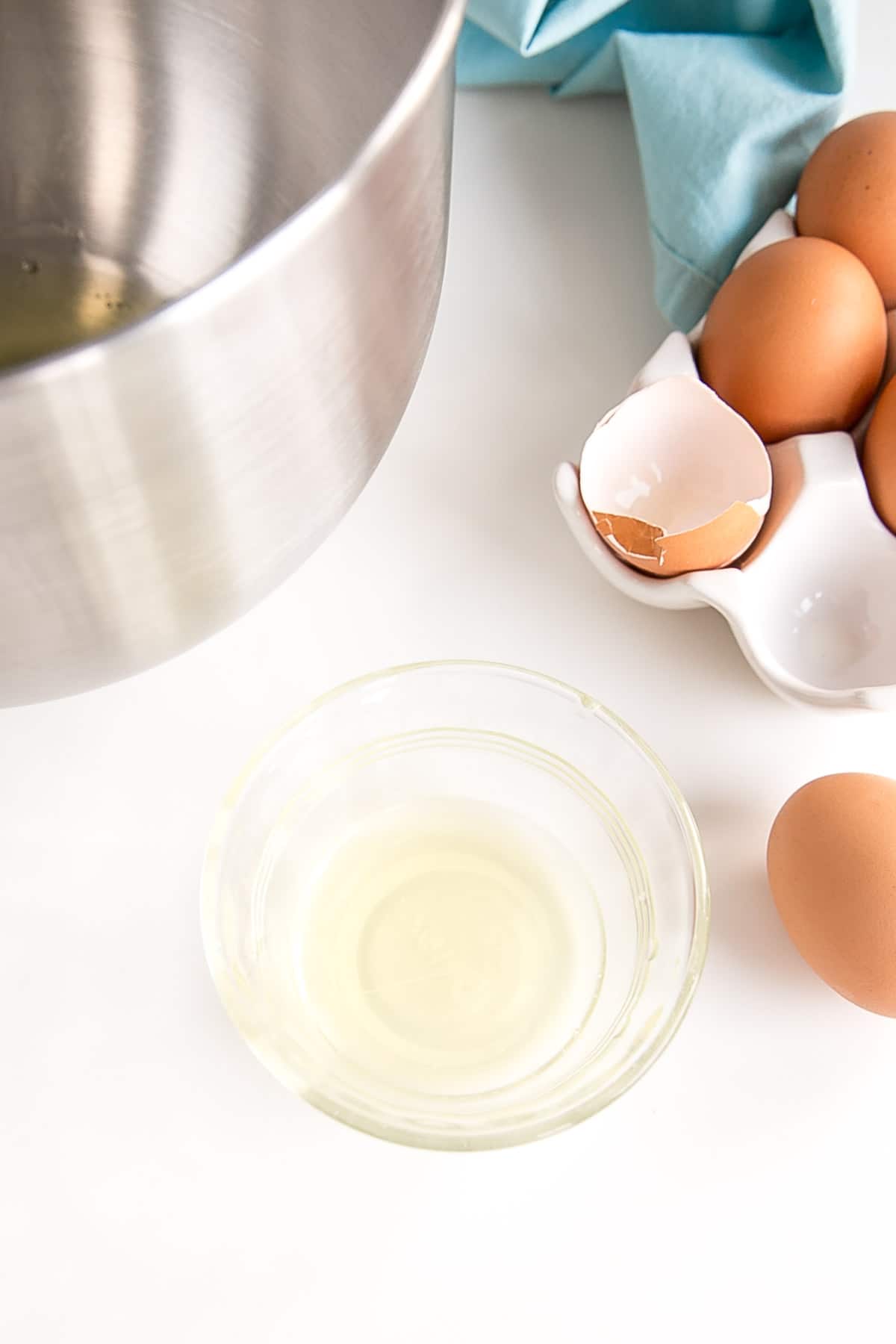
It’s best to separate each egg individually.
Even a speck of yolk will cause the meringue to not whip up properly. Do not attempt to make a meringue if your egg whites are not completely yolk-free.
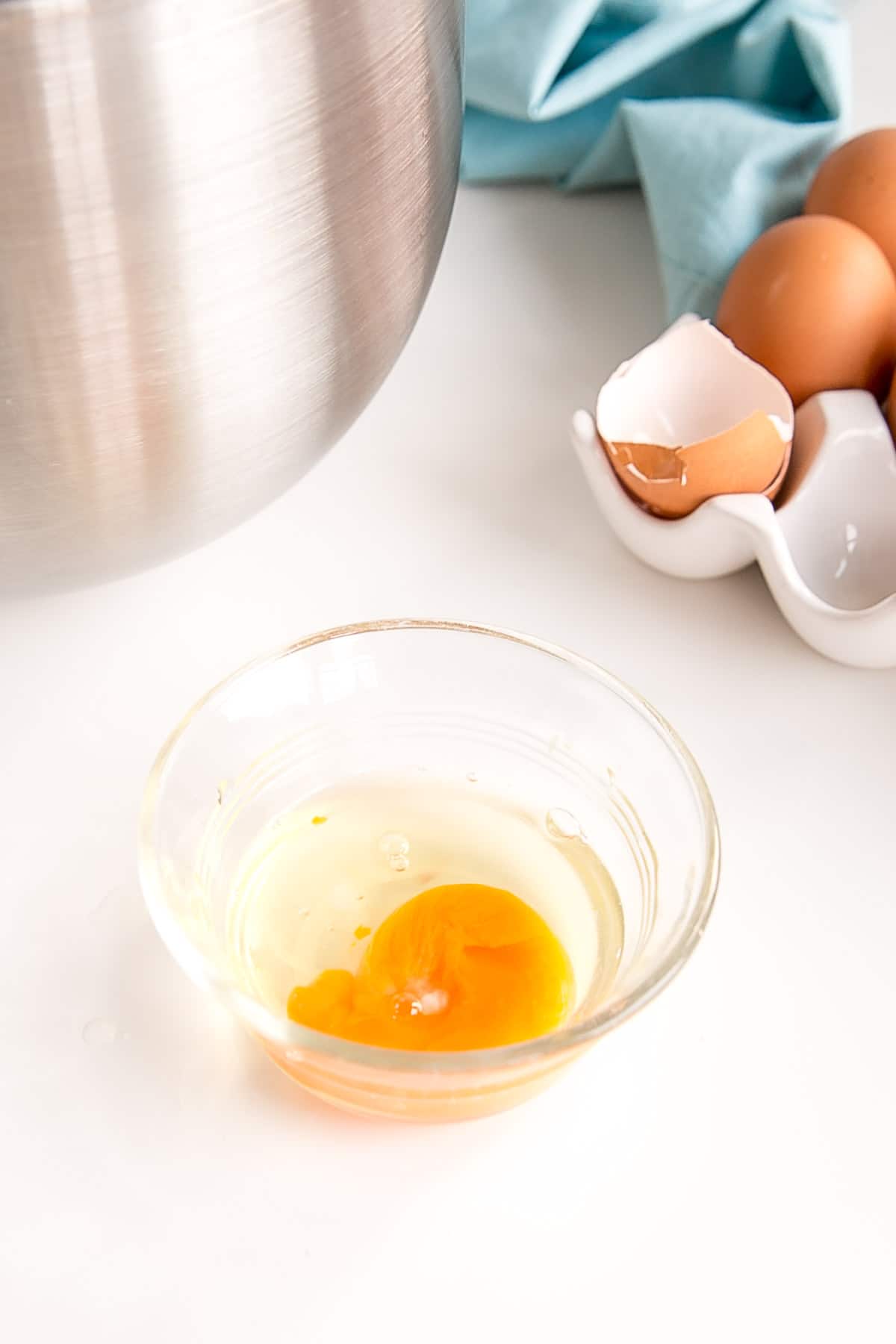
Note that the eggs do not need to be room temperature, since you’ll be cooking them anyhow.
Some people have had success with carton egg whites but, at this time, I cannot recommend them myself.
The carton whites I have tried have caused my meringue to stay flat and never stiffen. If you do want to experiment with carton whites, make sure the carton says something like “egg whites only” or similar.
Step #4 – Cook your egg whites & sugar
Once you’ve separated all your eggs, add them and your sugar into your mixer bowl and place it over the pot of simmering water.
I stir constantly at this point, with a clean hand whisk, to make sure the egg whites cook evenly. This process will take 2-3 mins depending on the number of egg whites you’re working with.
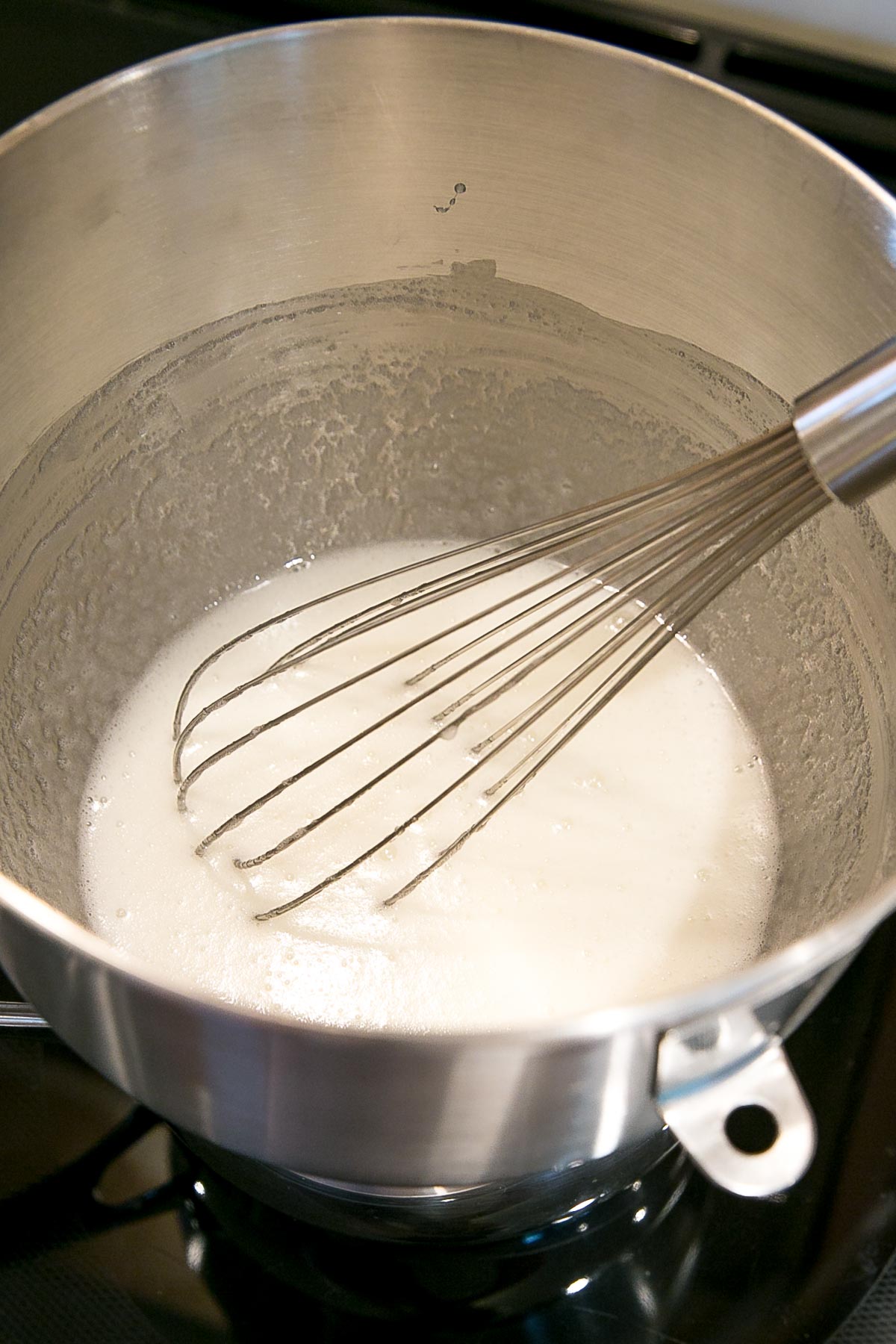
You’ll know the egg whites are done when the mixture is hot and no longer grainy to the touch.
I dip a (clean) finger into the mixture and rub it between my thumb and forefinger. If there is any graininess at all, I keep cooking them.
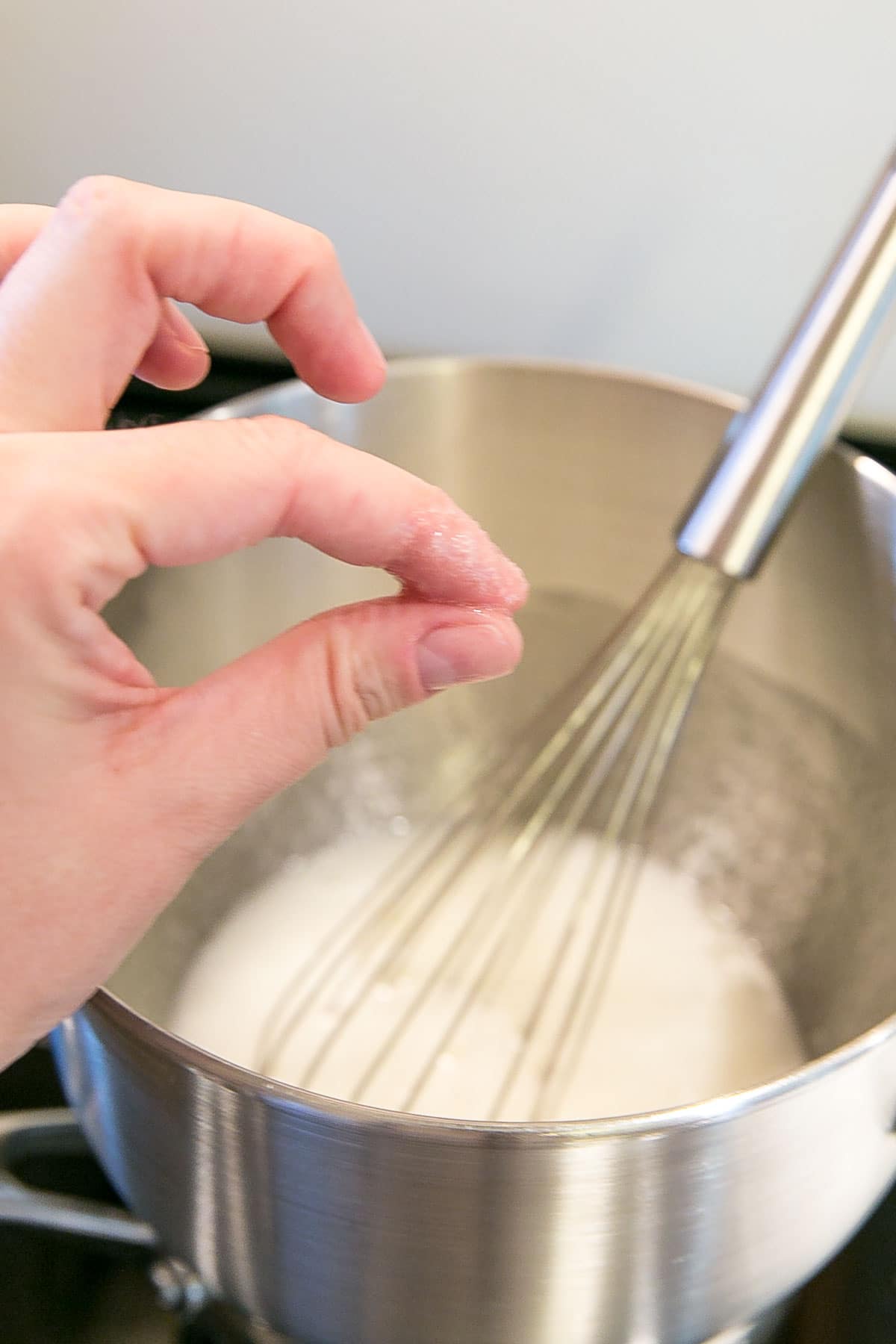
You want to make sure the mixture is hot to the touch too. Ideally, you’d use a candy thermometer to check that it has reached 160F. This is the most accurate way to make sure your whites are cooked fully.
I am too lazy to whip out a thermometer, and not concerned about eating raw eggs, so I do the touch test. If this is a concern for you, I recommend using a thermometer.
Step #5 – Whip your meringue
Remove your mixer bowl from the pot, wipe the bottom of the bowl, and place it on your stand mixer. Attach the whisk attachment and begin whipping.
I usually crank it right up to high speed (about 8-9 on my KitchenAid). You’ll want to whip this until the bowl is completely cool to the touch — this can take anywhere from 5-10mins.
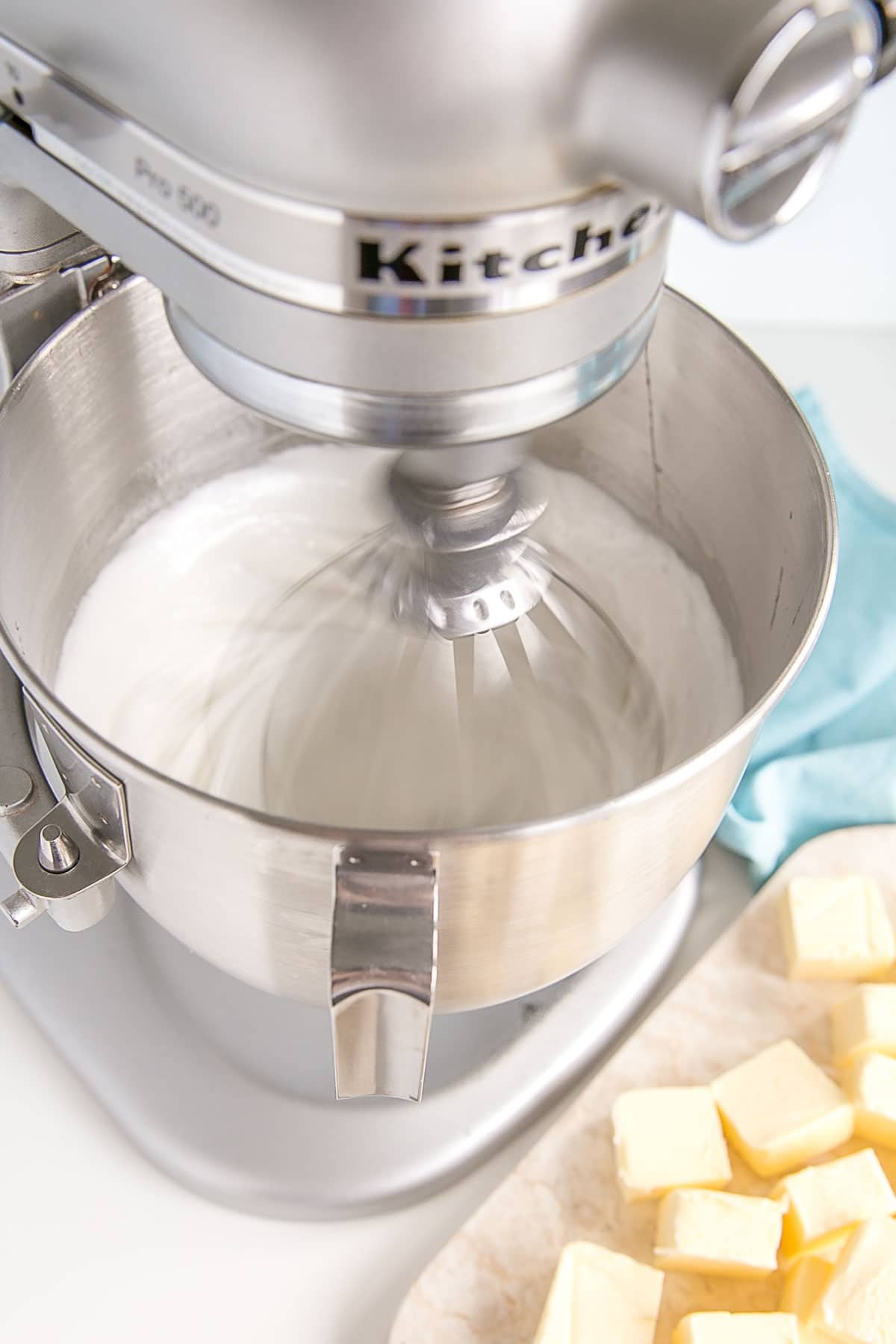
You’ll know if your meringue was successful if it holds a stiff peak. This is what it should look like – no droopy peaks!
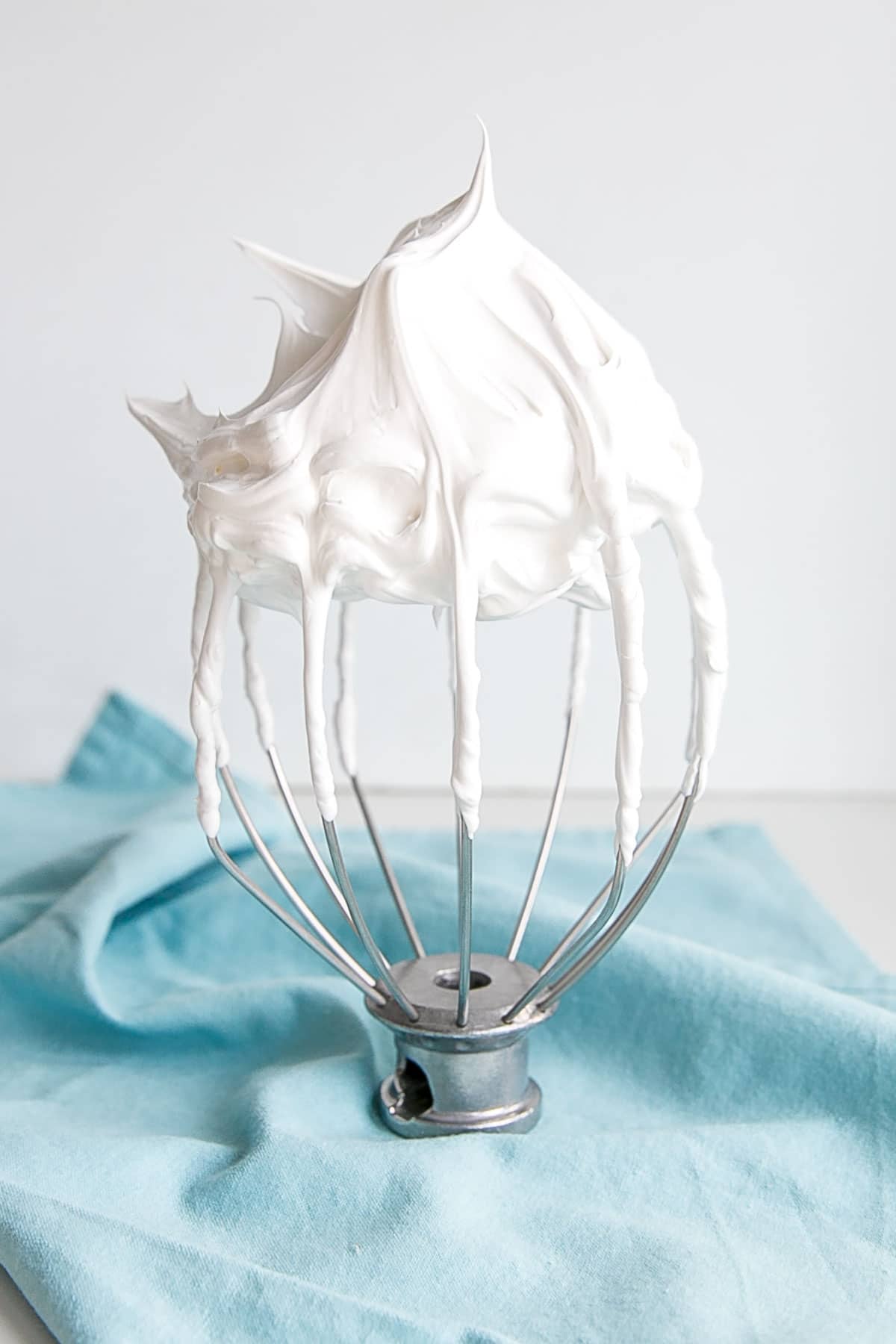
If your meringue is droopy, it was likely affected by either grease, yolk, or carton whites. See step #1. Unfortunately, if this happens, you will need to start over. There is no way to save the meringue at this point.
Step #6 – Cube your butter
While the meringue is whipping, cube your softened but still slightly cold butter. I roughly do 1″ or so cubes. It’s not an exact science, about 1 Tbsp or so each.
You will know your butter is the right consistency when you can press it with your finger and leave a bit of a dent in it.
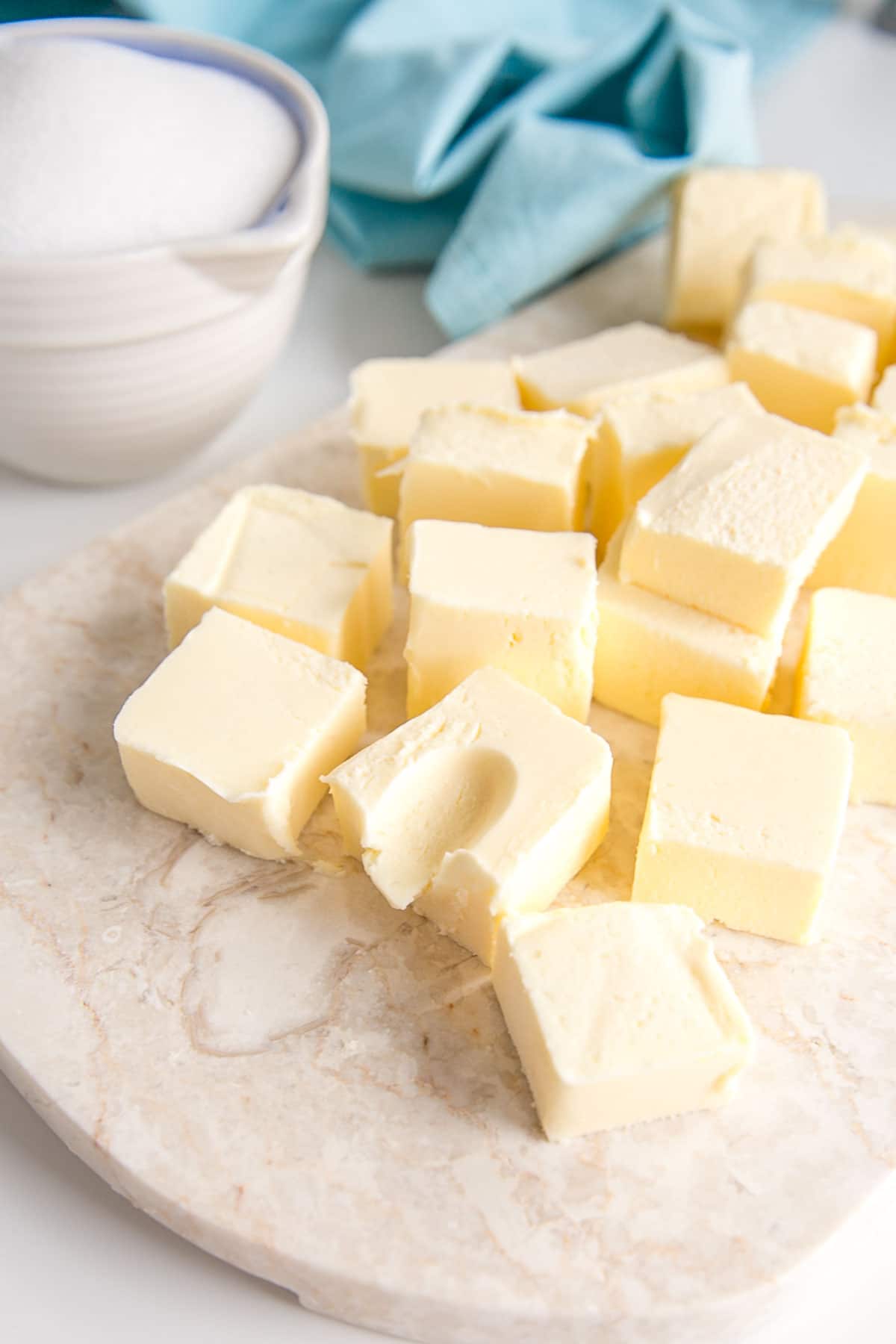
It’s important to note that your butter should not be too soft. If it’s so soft that you can press your finger through it easily, it will be too soft for your buttercream.
You can still use it, but you may need to chill your buttercream for a bit if it becomes soupy (see the Troubleshooting section below). I find it easier to deal with an SMBC that has used butter that’s too cold vs too soft.
Step #7 – Add the butter
When your meringue is completely cooled, stop your mixer and switch to the paddle attachment.
This isn’t critical, you can leave it on the whisk, but I like to switch to the paddle as I find that the whisk can incorporate too much air into the buttercream.
I also like that my paddle scrapes the sides of the bowl for me, which is a time saver.
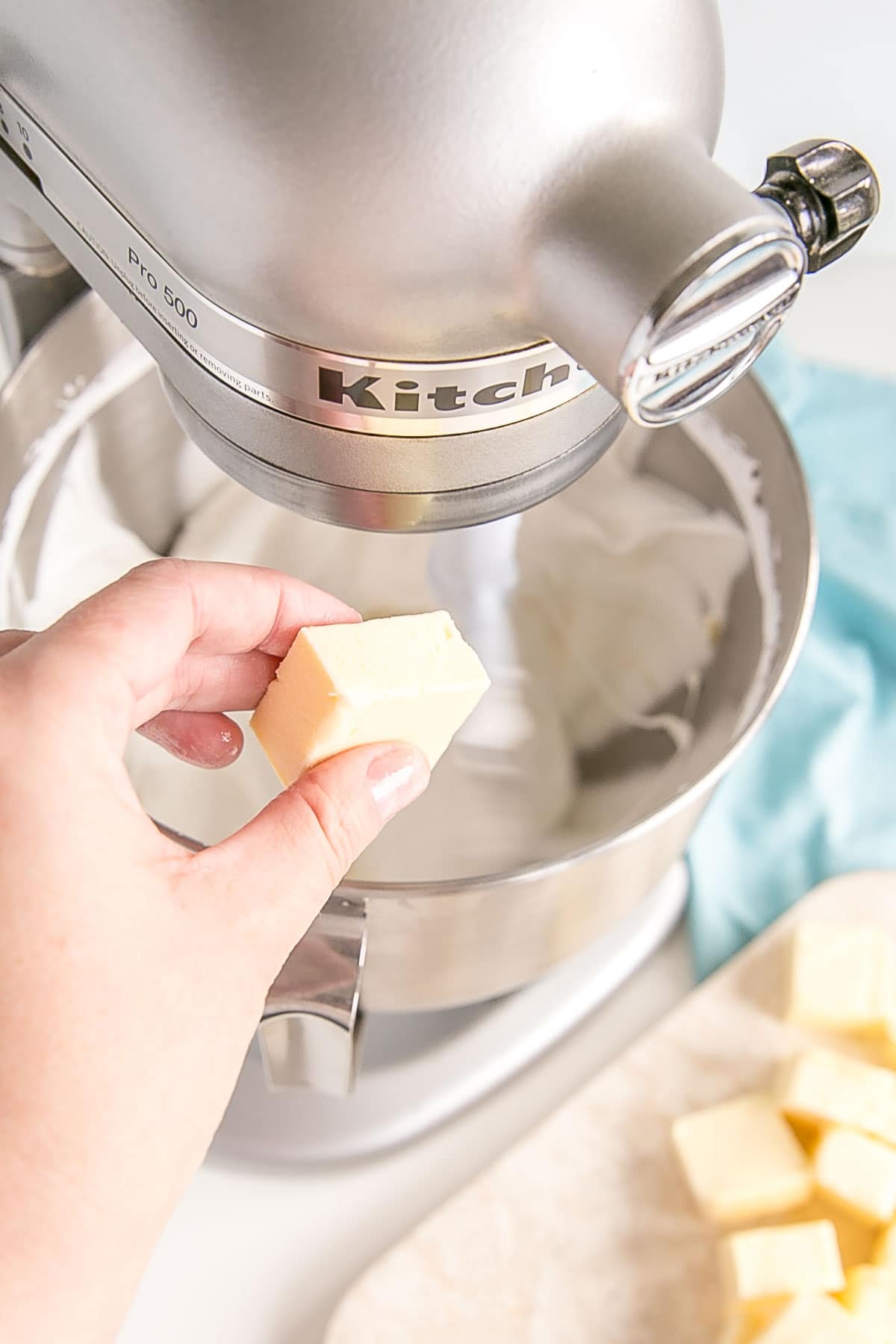
Set your mixer to medium speed (4 or so on a KitchenAid) and slowly start to add your butter cube by cube. Once all of the butter has been added, crank the mixer back up to high to beat the buttercream.
The buttercream can go through a few undesirable stages while it mixes. It can become soupy:
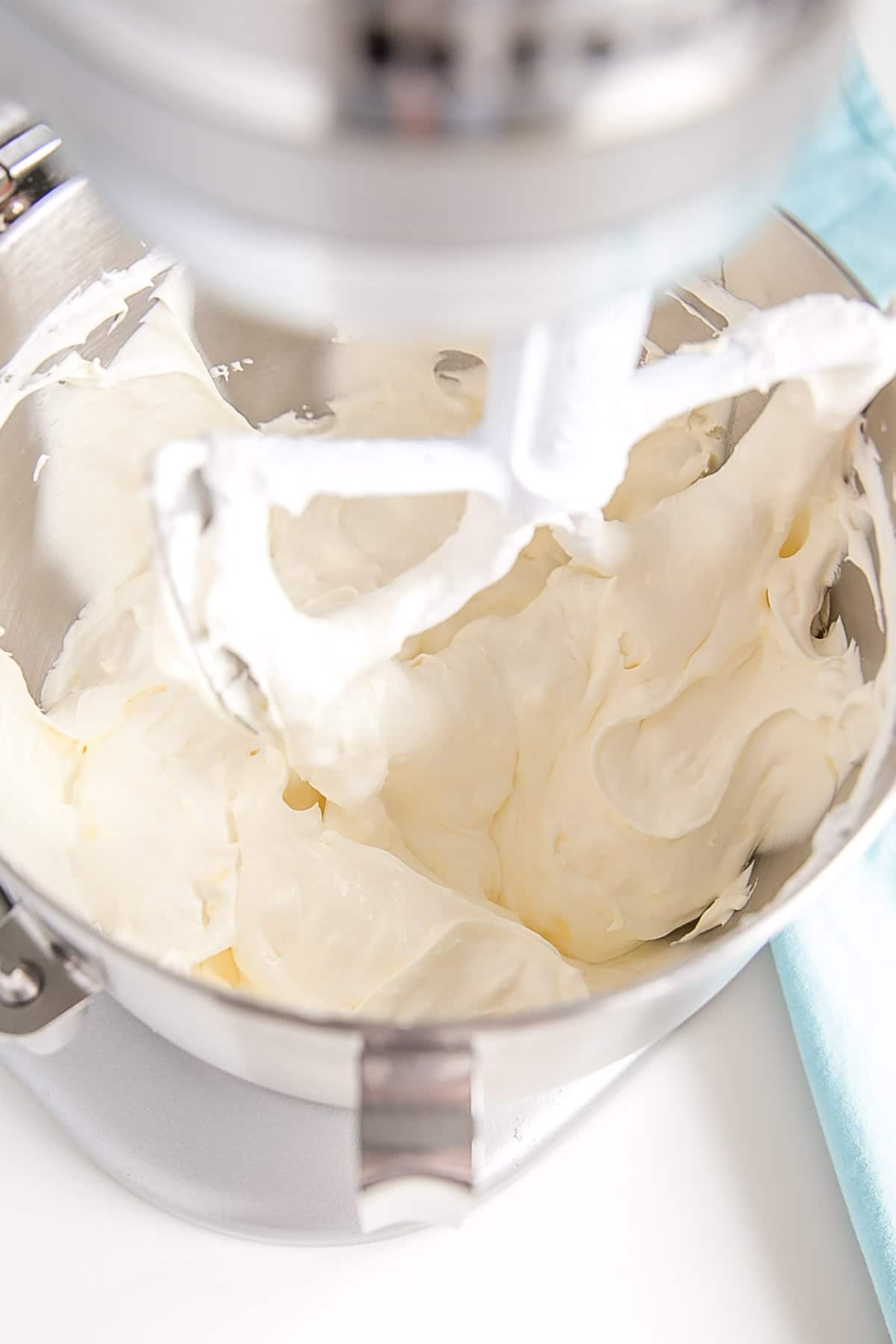
And it often curdles:
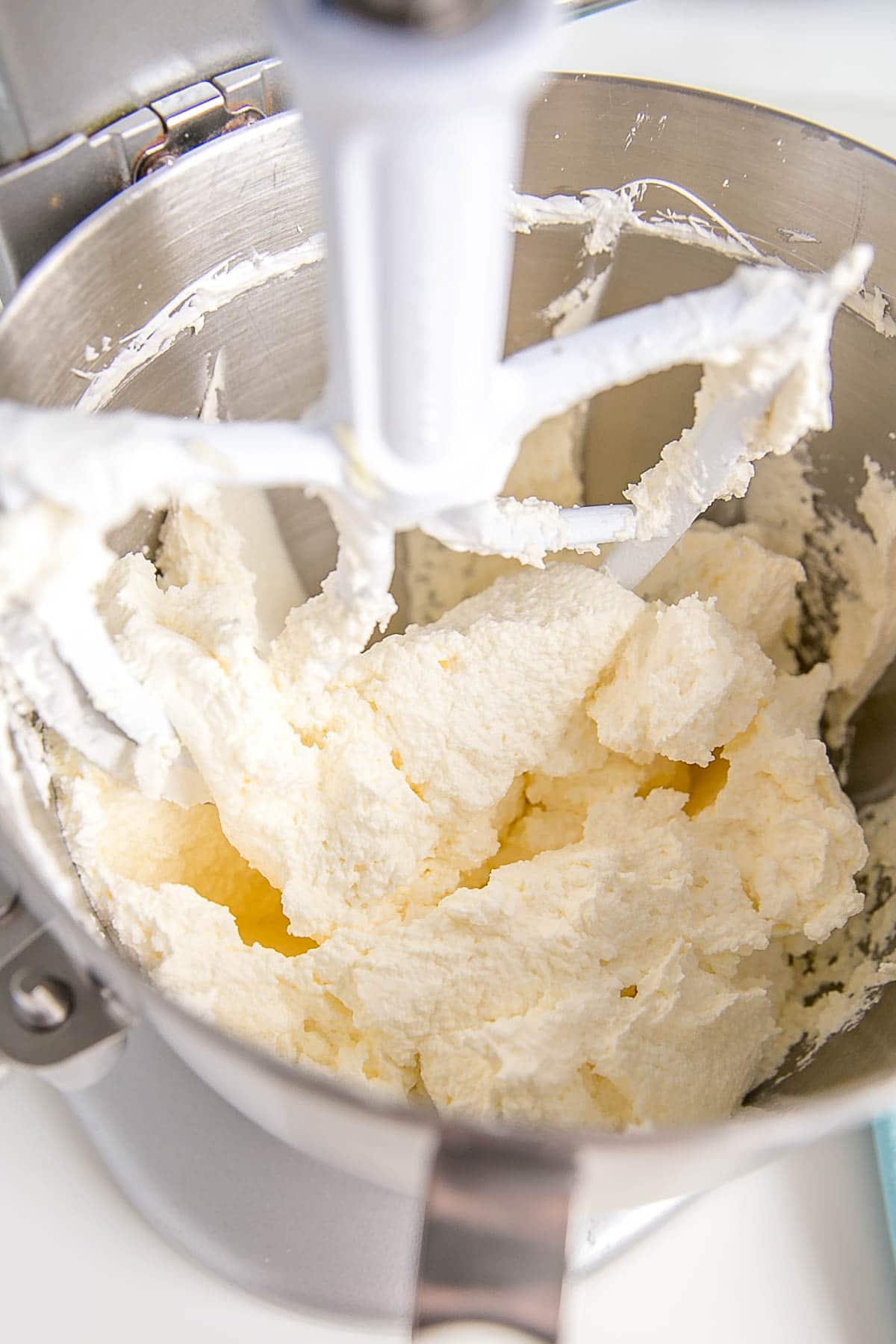
I find it best to walk away and come back after 5 mins to a (hopefully) perfect SMBC. See the Troubleshooting section below if this is not the case.
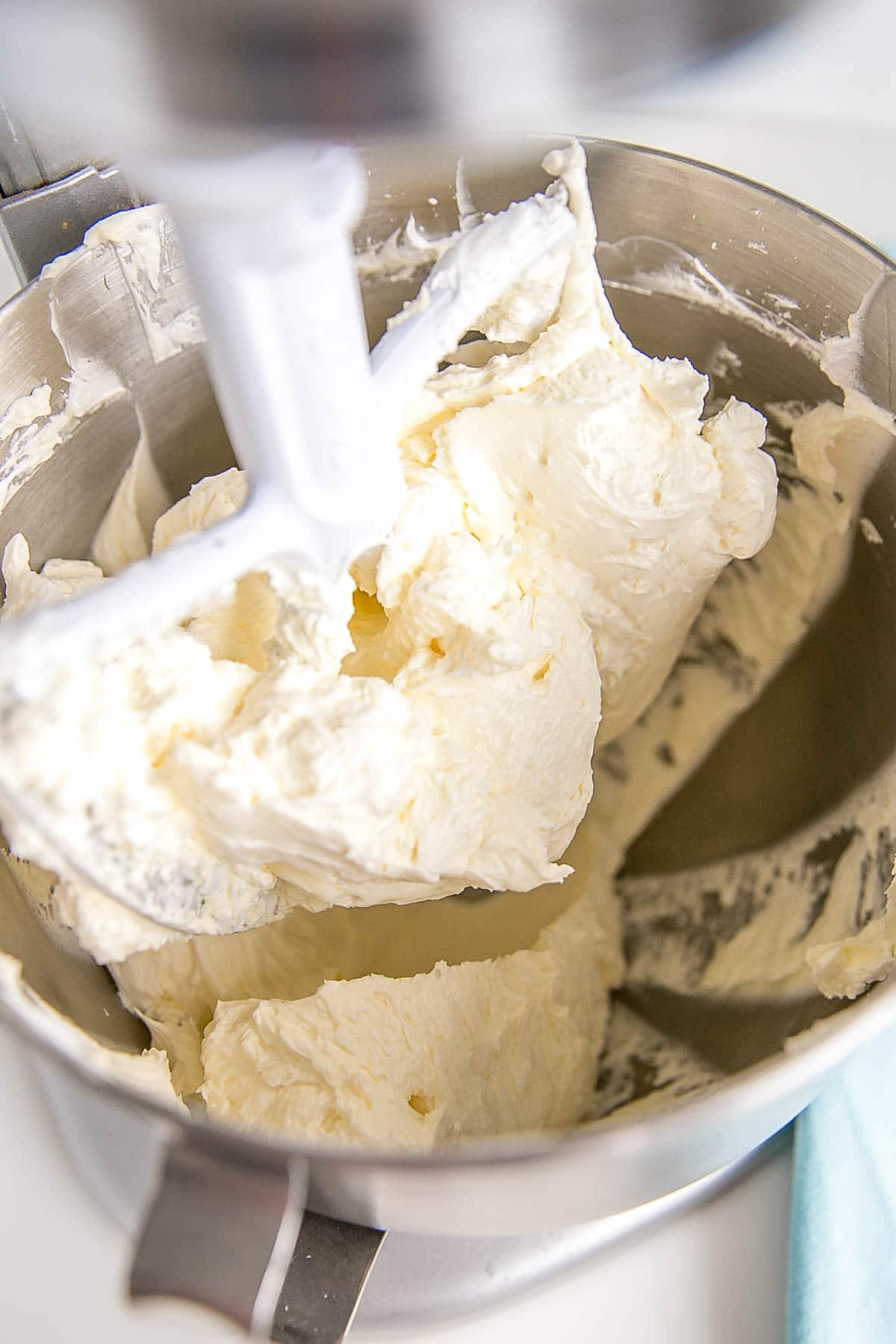
Once the buttercream is completely smooth, fluffy, and creamy, you can add in your flavorings (see below for a list of recipes).
How do I make my buttercream white?
This is a bit off topic, but also comes up often. SMBC can turn out a bit yellow depending on how much butter you use. This is not always a desirable effect, especially if you’re going for an all white cake.
The trick is to neutralize the yellow color by adding a bit of blue/violet to it.
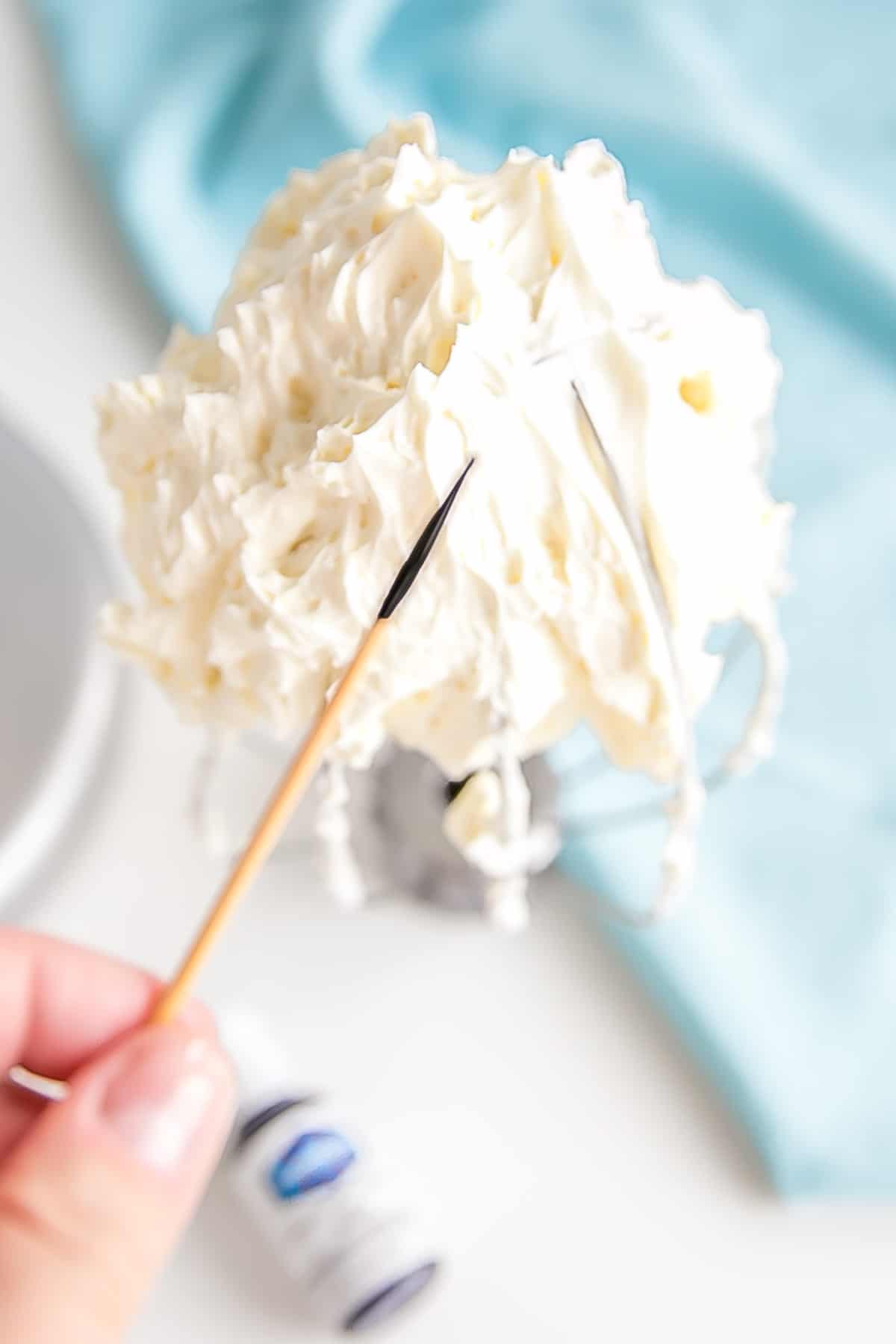
And I mean a bit. The amount on the toothpick above is more than I added. I basically swiped the toothpick over the buttercream on the whisk, so really only used one side of it.
I’d recommend starting with less and adding more as needed, or you’ll end up with a grey or bluish-looking buttercream.
Once the gel has been added (I used Americolor Violet), give the buttercream a good whip and you’ll see the yellow tint fade away. Add more color gel as needed.
Be sure to check out my detailed tutorial on How to Make Buttercream White for other tips.
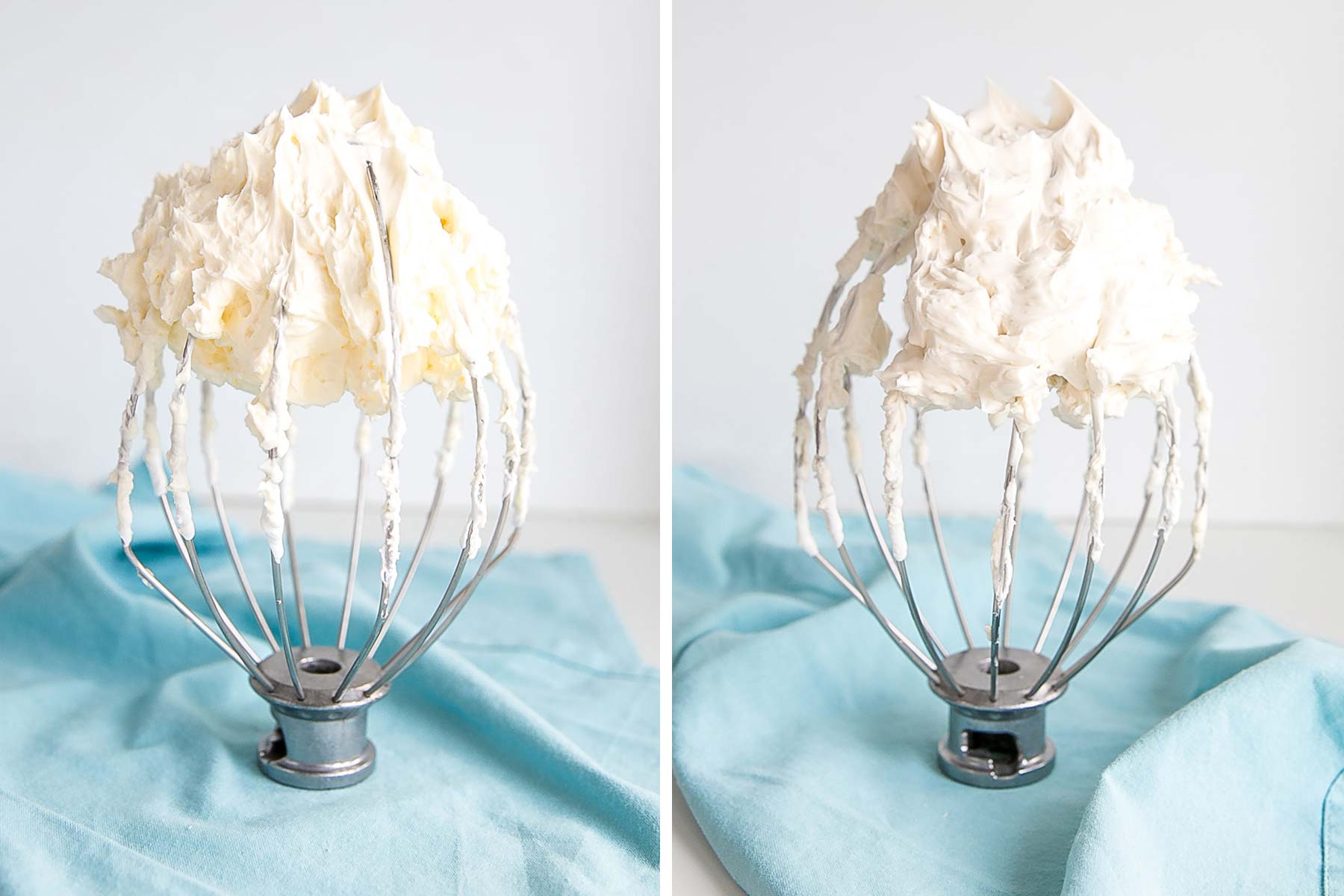
Troubleshooting Swiss Meringue Buttercream
Swiss meringue buttercream can be finicky. It’s temperamental and can cause a whole lot of unnecessary stress. The good news is that as long as your meringue was stiff before the butter was added, whatever issue you encounter after that is fixable.
Here are some common issues you may run into while making Swiss meringue buttercream, as well as my tips and suggestions on how to avoid/fix them:
- My meringue won’t whip up. This is either due to grease or egg yolks or both. See Step #1 of the tutorial above.
- My buttercream looks curdled. This is a common step when making SMBC. Once all the butter is added, it often goes through a phase where it looks curdled. If you keep whipping it, it will come together.
- My buttercream still looks curdled. If the temperature of the butter is too cold, it can be harder to get it to come together. You can either put it over a double boiler again like in Step #2, or warm the sides of the bowl with a hair dryer. One time, I had thawed some frozen SMBC and I didn’t completely bring it to room temperature before rewhipping. It looked like cottage cheese soup in my mixer. I thought it was a lost cause, but I heated the bowl a bit with a hair dryer and walked away for a few mins. When I came back it had come together perfectly! If you use the double boiler method, warm the buttercream just until the very edges start to melt, and then rewhip. You can also try to microwave 1/4 cup of the buttercream for a few seconds then drizzle it back into the buttercream with the mixer on low speed until it comes together.
- My buttercream is soupy. This is the opposite problem of curdled buttercream. This occurs because either the meringue was too warm when you added the butter or your butter was too soft, or both. Pop the whole bowl and whisk into the fridge for 20mins and then rewhip. Depending on how warm it was, you may need a couple of sessions in the fridge.
- My buttercream is grainy. This is due to the sugar not being dissolved properly in Step #4 above. Once the meringue is whipped, there is nothing you can do to fix this. It’s best to start over.
- My buttercream is greasy. SMBC is more buttery than an American buttercream, but it should not feel greasy. If you haven’t added more butter than the recipe calls for and your meringue was stiff, then the greasiness is likely due to the buttercream not being whipped for long enough. It’s also good practice to rewhip the SMBC if it’s been sitting out on the counter for a while.
- The buttercream gets hard in the fridge. This is normal. Just like the butter it’s made from, it will firm up to the consistency of butter in the fridge. When you let it come to room temperature it will soften again.
- It tastes too buttery. Some people just don’t like meringue buttercreams — they’re not for everyone! But the buttercream should be light and fluffy, not thick and greasy. If yours tastes like you’re eating a stick of butter, perhaps your meringue wasn’t whipped to stiff peaks before adding butter, or the butter was too cold, in which case it just needs some more whipping. Or you added too much butter.
Frequently Asked Questions
- Can I make Swiss meringue buttercream in advance? Yes! You can leave it at room temperature for a day or two, refrigerate for up to two weeks, or freeze it for up to 3 months. Be sure to store it in an airtight container. You must bring the buttercream completely to room temperature and rewhip before use. If the buttercream separates, it was still a bit too cold. See Step #3 above in the Troubleshooting section.
- How do I thaw my buttercream? Thaw it on the counter. It will be too hard if you thaw it in the fridge. I thaw mine overnight. Rewhip before use. See above.
- How long does Swiss meringue buttercream last? It will last for a day or two at room temperature, 2 weeks in the fridge, and 3 months in the freezer. Be sure it is properly stored in an airtight container or a freezer bag.
- Is Swiss meringue buttercream safe to eat? Yes. If you cook the eggs to 160F the buttercream will be safe to eat.
- Can I flavor Swiss meringue buttercream? Yes. Once the buttercream has come together, you can add any kinds of flavorings, extracts, powders, or chocolate — see list below for a list of recipes.
- Can I color Swiss meringue buttercream? Yes. Though SMBC is more difficult to color than an American buttercream. The color doesn’t take as well, so you may need more color gel. Be careful not to add too much, as the buttercream may split. You may want to look into powdered food coloring if you’re wanting to do very vibrant colors. I don’t recommend using liquid food coloring as it is not intense enough an can cause the buttercream to split. For more tips on getting rich, dark colors with SMBC see my Chocolate Peppermint Cake post.
- I don’t have a stand mixer. Can I use my hand mixer to make Swiss meringue buttercream? You probably can, but I do not recommend it. You’d be whipping forever! First to cool the meringue, and then when the butter is added. It can be a 10-15min process with a stand mixer, so I imagine it could take twice as long. So… doable if that’s all that you have at your disposal, but just know you’re in for a long haul.
Swiss Meringue Buttercream Recipe
The recipe I’m including below is the standard SMBC recipe that I use, though I tend to experiment a lot with it and sometimes add an extra egg white or use a bit less butter, depending on the amount of frosting I need.
I haven’t run into any issues doing this, but it’s important not to add more butter than the recipe calls for unless you’re also increasing the egg whites & sugar.
Swiss Meringue Buttercream Variations
- Blueberry (or any kind of berry)
- Brown Butter
- Brown Sugar
- Caramel
- Chocolate
- Cinnamon
- Coconut
- Dulce de Leche
- Espresso
- Honey
- Maple
- Mint
- Mocha
- Peanut Butter
- Vanilla
- White Chocolate
I hope you’ve found this guide helpful and that it’s given you the courage to give Swiss Meringue Buttercream a try! It truly is one of the most delicious buttercreams out there.
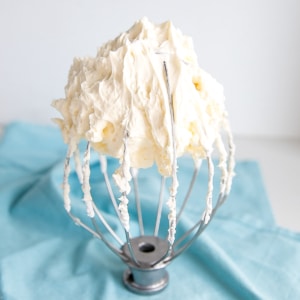
Swiss Meringue Buttercream Recipe
Ingredients
- 6 large egg whites
- 2 cups granulated sugar
- 2 cups unsalted butter softened but still a bit firm, cubed
- vanilla or other flavoring to taste see post for options
Instructions
Swiss Meringue Buttercream
- Place egg whites and sugar into the bowl of a stand mixer, whisk until combined.
- Place bowl over a pot with 1-2" of simmering water and stir constantly with a whisk until the mixture is hot and no longer grainy to the touch or reads 160F on a candy thermometer (approx. 3mins)
- Place bowl on your stand mixer and whisk on med-high until the meringue is stiff and cooled (the bowl is no longer warm to the touch (approx. 5-10mins)).
- Switch to paddle attachment (optional). Slowly add cubed butter and mix until smooth.
- Add flavorings as desired whip until smooth.
Notes
- This recipe makes enough to frost a two layer 8″ cake or a three layer 6″ cake.
- The recipe can be made with 3 cups of butter instead, if you need more frosting.
- See blog post for tips and troubleshooting.
Updated Nov 2, 2022. Originally published Jan 2, 2019
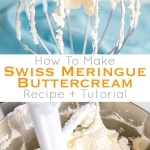

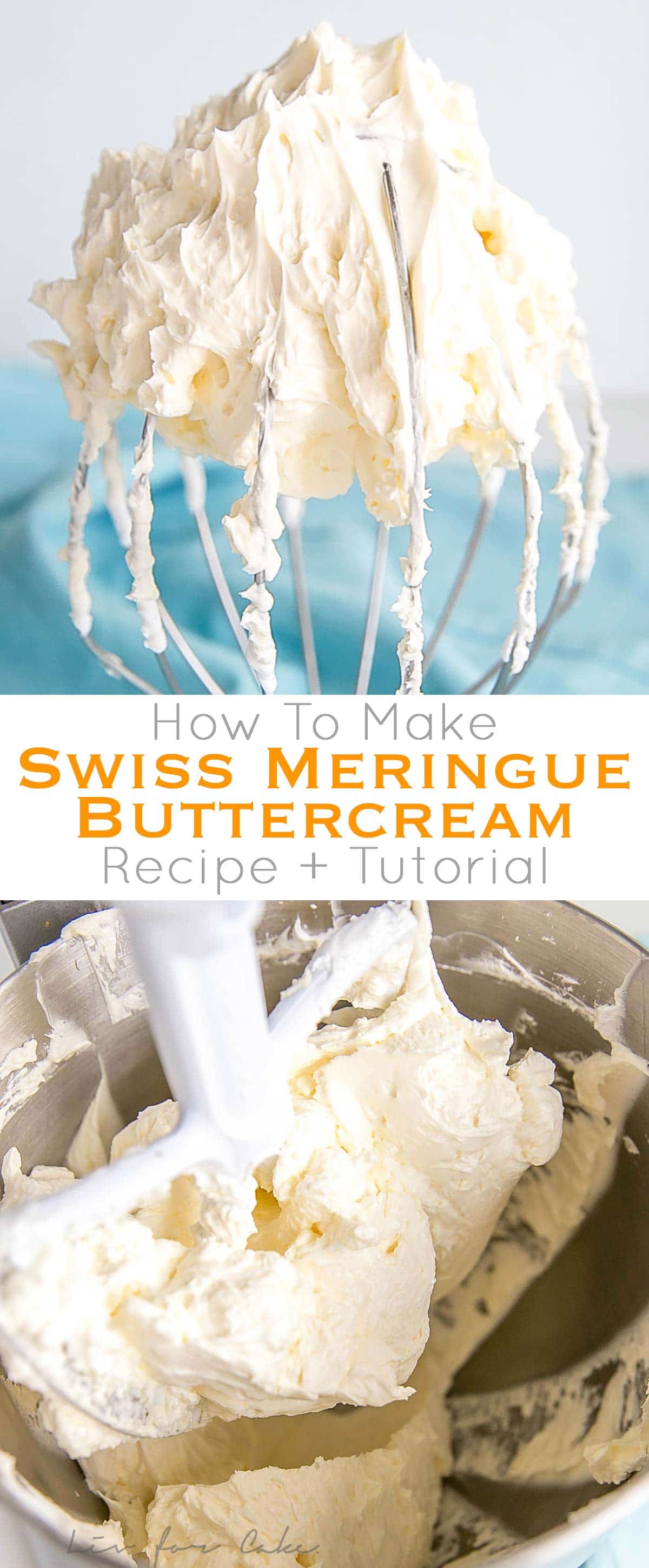
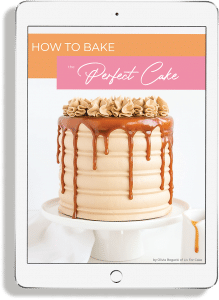









Sandie Playdon says
I’ve just made the SMBC for the first time in a dummy run ready for making my step son’s wedding cake. Thanks to the instructions and recommendations in your recipe my first attempt was very successful.
Olivia says
Hi Sandie! I am so happy to hear that! Thanks for the feedback 🙂
Apu says
I am a home baker and I must tell you that I have tried many many recipes but I always come back to yours. Your vanilla cake recipe is one of my favorites. I am daring to try SMBC for the first time following your recipe. Keeping fingers crossed as right now it’s in the curdled state.
Olivia says
Hi Apu! Thanks so much! I hope the SMBC turned out well for you 🙂
Maggie D. says
I found your website through Google and I am so happy that I did! I never made SMBC before and your instructions and tutorials are so helpful and detailed. I made your coconut cake with coconut SMBC for Thanksgiving 2 years ago and it was delicious! Your homemade chocolate cake recipe is absolutely the best. My coworker went so far as to say it was the best chocolate cake he ever had. I cannot even say how many of these cakes I have made in the last two years since finding your website but it’s a lot. Good thing I love to bake! Thank you for sharing your recipes and your knowledge. Happy baking!!!
Olivia says
Thank you so much for the wonderful feedback, Maggie! You totally made my day. I’m so glad you love SMBC as much as I do!
Elizabeth Hawkey says
Thank you for all of your delicious and easy-to-understand cake recipes! You are my go-to!
I have an urgent question about Swiss meringue buttercream. I have never had a problem making it from several of your cake recipes until yesterday. I was making your maple cake again and as usual made the maple SMBC in the recipe. The meringue was stiff and I used 3 cups of butter (but actually minus 2 tablespoons). This time it tasted way too buttery, so I left out 2 tablespoons from the 3 cups of butter. I just checked this basic SMBC recipe here and you use equal 2 cups sugar to 2 cups butter. Will make it again today—should I make the maple version with 2 cups butter instead?
So confused.
Olivia says
Hi Elizabeth! The standard ratio is for 3 cups of butter but I find that often makes too much buttercream so I use two most of the time. You can use either amount of butter or something in between if you like.
Elizabeth Hawkey says
Thank you so much!
Elizabeth Hawkey says
Thank you so much! You are the best!!
Mallory Adams says
If I double your recipe but want a lighter, less buttery SMBC would you recommend doing 3 cups of butter instead of 4?
Olivia says
Hi Mallory! Yes, you can use 3 cups instead.
Jiya says
Hi.. how can i fix the taste of my smbc which I feel is very buttery? And I forgot to add vanilla extract? P please help.
Olivia says
Hi Jiya! I talk about this in the post: “It tastes too buttery. Some people just don’t like meringue buttercreams — they’re not for everyone! But the buttercream should be light and fluffy, not thick and greasy. If yours tastes like you’re eating a stick of butter, perhaps your meringue wasn’t whipped to stiff peaks before adding butter, or the butter was too cold, in which case it just needs some more whipping. Or you added too much butter.” I recommend whipping it more and also adding the vanilla. That will make a big difference.
Sarah C says
I am going to make this this weekend! Do you recommend superfine granulated sugar (caster sugar) instead of granulated sugar? Would the conversion be the same 200g:200g?
Olivia says
Hi Sarah! I just use regular granulated sugar.
Tahere says
And another question!
As I don’t have a stand mixer, can I have short rests during whipping the buttercream?
Olivia says
That should be fine. It will be more of a challenge though with a hand mixer. See the details in my post about this if you haven’t already. Let me know how you like it!
Tahere says
Hi again
Can i reduce the amount of sugar,
Olivia says
HI Tahere! For best results, use the recipe as written. Reducing the sugar will affect the structure of the meringue.
Tahere says
I tried your german buttercream and it was very delicious. Since iranians are unfamiliar with all kind of buttercreams and love whipped cream, i want to know what does it taste like. Is it as delicious as german?
Olivia says
Hi Tahere! This is my favourite buttercream but it is sweeter than the German buttercream recipe.
Kayleigh says
Every single recipe of yours works perfectly and tastes amazing! You make me confident to make cakes for my family! Thankyou so much for the work you put into your recipes x
Olivia says
Thanks so much Kayleigh for the wonderful comment! I’m so happy you like my recipes 🙂
Catherine says
I made this buttercream once and really liked it. I’m making a 4-layer 6″ cake and a 4-layer 8″ cake, can I double or triple the recipe?
Olivia says
Hi Catherine! Yes, as long as your mixer can handle the volume.
Rachel says
I noticed in your post about your Swiss Meringue Buttercream recipe that you experiment by adding an extra egg white or a bit less butter depending on the amount of frosting you need. I have been wondering how the amount of butter added to Swiss Meringue Buttercream affects the frosting. Does the amount affect the stability of the buttercream? It looks like you use a 1:1:3 ratio of egg white/sugar/butter. I just used a recipe that is a 1:2:4 recipe and found it to be far to buttery tasting, even after I had whipped it light and fluffy. I did some more research and found recipes that are 1:2:3 and some all in between. I am going to try your recipe. What do you find that is better about the ratio you use? I am always interested in the science of baking. Thanks.
Olivia says
Hi Rachel! Yes, the amount affects the stability but also the flavour. Less butter means a lighter, softer frosting, but a less buttery taste. The standard SMBC recipe is 1:2:3 (sugar:butter:whites). That often makes too much buttercream so I use less butter.
GKW says
I avoided SMBC like the plague but your tutorial gave me the confidence to try…..and it came out successful on the first attempt! I was thrilled!! Thank you for a great tutorial!
I’m going to be making SMBC again this week for a birthday cake and have a question. How would you personally go about making orange SMBC? My goal is to make orange SMBC to go on an orange cake but I’m a bit nervous about how to attempt this and what to use/what proportions. I’d appreciate any insight you might have on this. Thank you!!
Olivia says
Hi GKW! I am so glad to hear you tried it and loved it! Yay for a successful first attempt 🙂 For Orange SMBC there are a couple things you could do. You could just add a bunch of orange zest to it (a couple Tbsp or so) or add orange curd which would be more effective flavour wise I think. You can use my lemon curd recipe and swap the lemon for orange and it will work great. I would add it 1/4 cup at a time to the buttercream until you get the flaovur you want. You can also add additional zest too.
Steph says
This is my favorite buttercream recipe! Would it still working using plant based butter? I’m making a cake for a friend who is lactose intolerant and would love to still use this recipe (as opposed to a full vegan one with aquafaba). Thanks!
Olivia says
Hi Steph! I’m so glad you like it. I have never tried it myself so I can’t guarantee the results. I would do a half batch to test and see if the texture works for you. Let me know if it does!
Steph says
It worked wonderfully! The texture is a little lighter, almost more whipped cream like, but it still was sturdy enough for piping!
Olivia says
Oh perfect! Thanks for following up 🙂
Meredith says
It worked! I was intimidated by this recipe. Read it like 15 times lol. But, was able to make it the first time around. After whipping the egg whites I put it in the fridge for 20 minutes then added the butter cubes. It still seemed pretty soupy but kept going. I tinted it blue with about a teaspoon of blue gel food coloring from Publix. The cake turned out so great! The frosting was not too sweet and such a nice texture to get that nice smooth finish on the sides and tops of a three layer 8″ cake. Thank you.
Olivia says
Hi Meredith! Yay! So happy it worked well for you. Thanks for your tips!
Geniveve says
Thank you, thank you, thank you! This recipe with the explanations gave me the confidence to try a SMBC. To be honest the first attempt didn’t work out but your trouble shooting let me know that there was no saving it and to start again. It whipped up grainy. The second round I pulled out my little used candy thermometer and …. success! I was a bit impatient for the bowl to cool so I could add the cubed butter so I grabbed a pair of gel cold packs from the freezer and held them to the sides of the mixing bowl. It cooled down nicely. Splitting the SMBC to do two flavors for cutout cookies for my friend’s kids.
Olivia says
Hi Geniveve! Yay for a successful SMBC! I’m glad you didn’t give up after the first attempt and gave it another go. Glad all the tips helped too!
Jay says
I’ve made this buttercream and it was beautiful. But today I made Italian butter cream with soft butter and it came out with lumps of butter. I even microwaved in for 15 seconds to make sure it was soft. Will swiss buttercream be as stable as italian? And what can you do to bring back lumpy butter cream? If I add melted chocolate also, would that help it to become more stable. I think I’m gonna swap to Swiss buttercream!
Olivia says
Hi Jay! Italian is a bit more stable than Swiss but honestly Swiss is not unstable and totally wonderful to work with (and easier!). Lumpy meringue buttercream usually means the butter was too cold. You should be able to save Italian buttercream using the same tips I have here for Swiss.
Sheri says
I love your recipes!!!y Your site and cookbooks are my “go to” cake source.
I do have 1 question about SMBC. I find that it takes a LONG time for my stainless mixing bowl on my Kitchen Aid to be completely cool to touch. 20+ minutes. I stopped using the mixing bowl to cook the whites and it is still ages before it cools down. Any suggestions? Am I heating it up too fast (I use a thermometer). Any help would be appreciated.
Olivia says
Hi Sheri! Hmmm, I wonder if it heats up too much? I use a low simmer to cook the whites. If it’s still too warm but the meringue is whipped, you can help cool it by putting a bag of frozen peas or similar under the bowl (touching) while it’s whipping.
Sheri says
I used a low summer the very first time I made it and it took forever!!!! I use medium heat but maybe I’ll have to live with it taking longer. It turns out great so I guess it’s ok. Thanks!!!
Imani says
I love your buttercream frosting! This is the only frosting I use. If I wanted to dye the frosting a different color, would it be best to use gel icing food coloring?
Olivia says
Hi Imani! Yes, gel or powdered coloring will work best. SMBC is more difficult to color though than an American buttercream. It’s hard to get those deep, rich colors.
Imani says
Hi Olivia! I just saw this and forgot to reply! Thank you! I use your recipe to make cupcakes, would you say it’s accurate that one batch should frost about 30 cupcakes?
Olivia says
Hi Imani! I can’t say for sure as I’ve never used it to frost cupcakes. It depends on how much frosting you use for each one too.